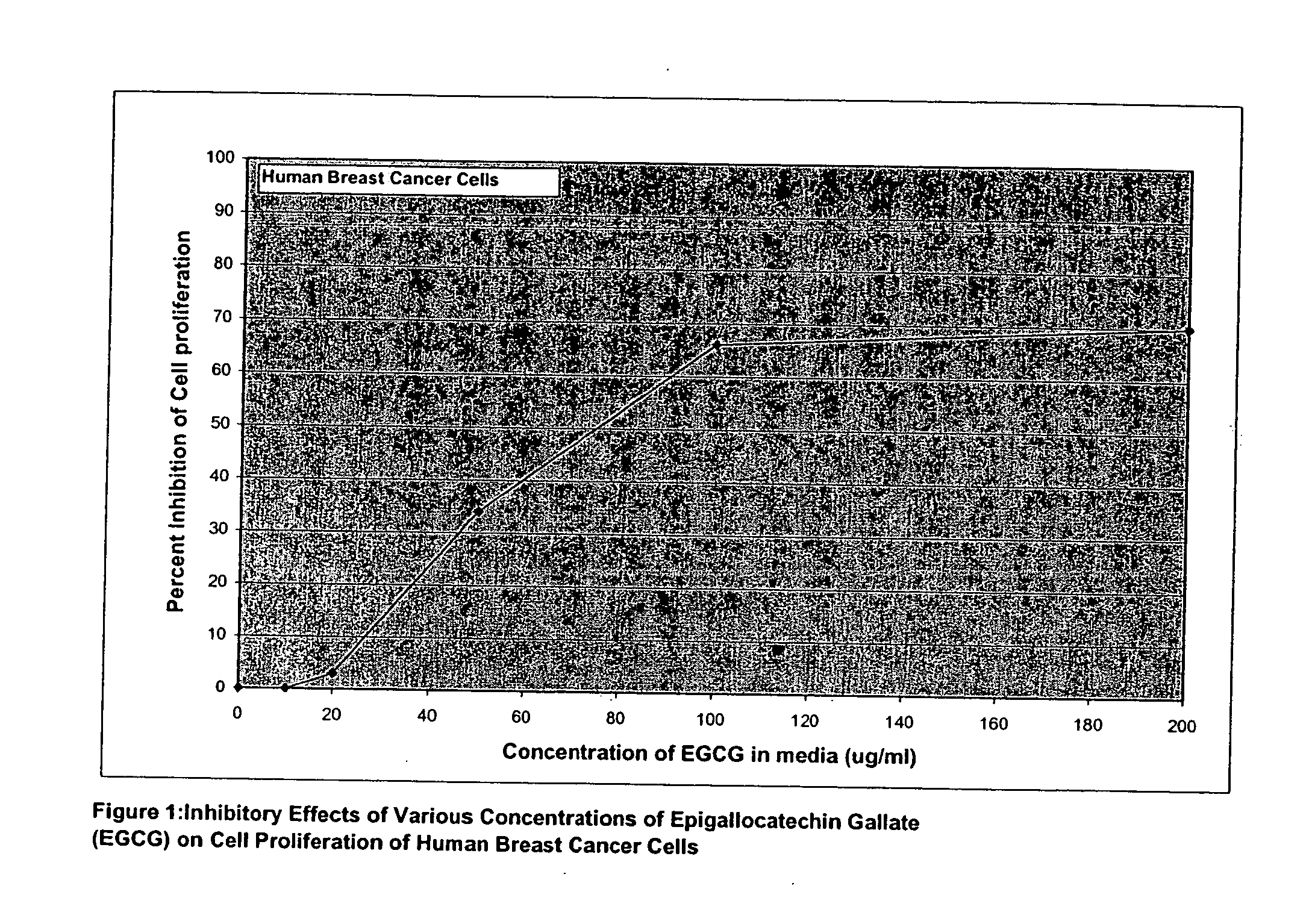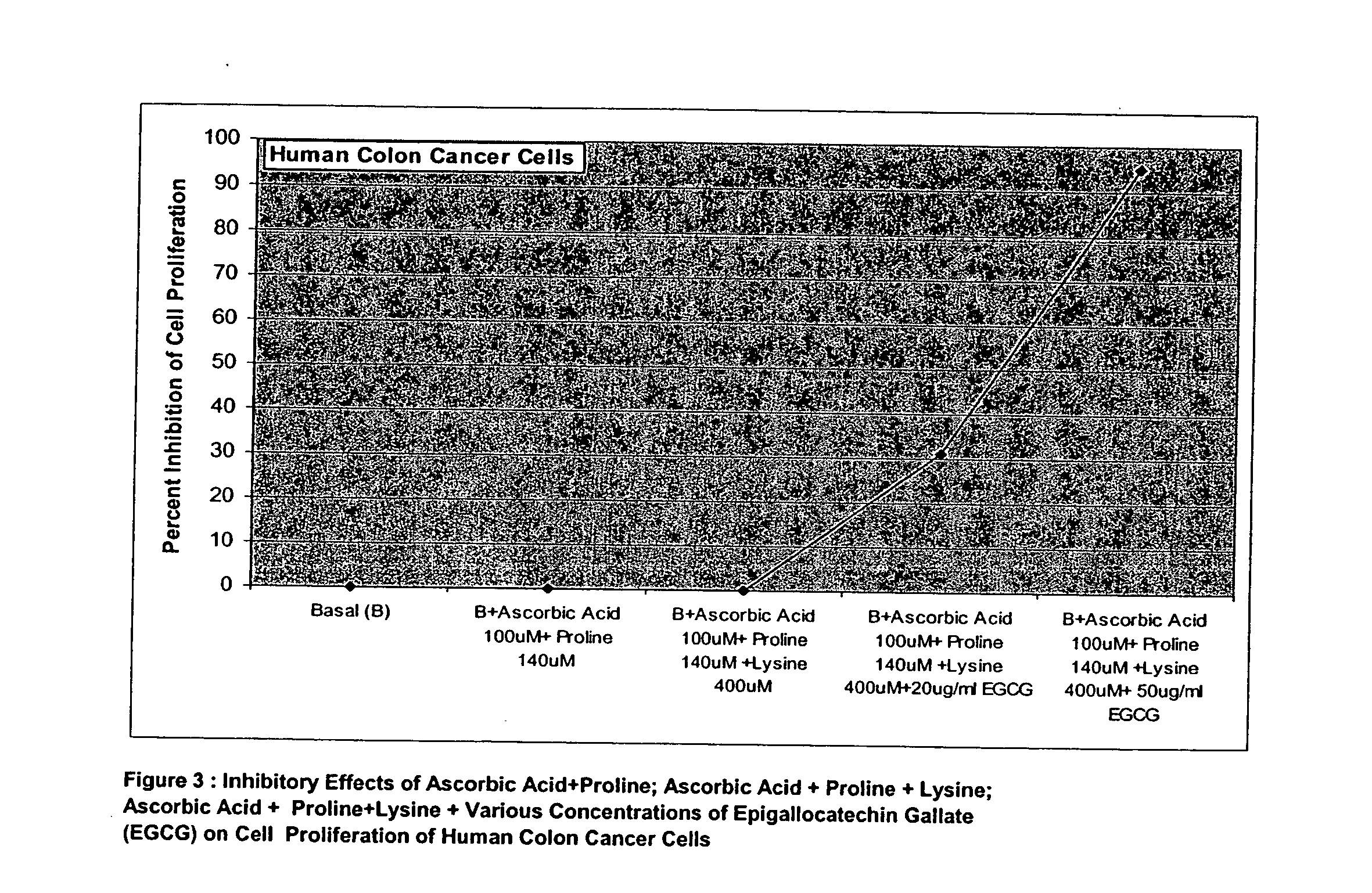Composition and method for treatment of neoplastic diseases associated with elevated matrix metalloproteinase activities using catechin compounds
a technology of matrix metalloproteinase and catechin, which is applied in the direction of peptide/protein ingredients, immunological disorders, antibacterial agents, etc., can solve the problem of greatly reducing the therapeutic value of polyphenols including egcg, low tissue concentration
- Summary
- Abstract
- Description
- Claims
- Application Information
AI Technical Summary
Benefits of technology
Problems solved by technology
Method used
Image
Examples
example 1
Inhibitory Effects of Cpigallocatechin Gallate (EGCG) on Cell Proliferation of Human Breast Cancer Cells (MDA MB 231)
In these studies, 5×104 breast cancer cells (MDAMB 231) were seeded in each of the wells of 24-well plate. Control group refers to breast cancer cells that were grown in Liebovitz's media supplemented with 10% fetal bovine serum (FBS). Treatment group refers to breast cancer cells that were grown in Liebovitz's media supplemented with 10% fetal bovine serum (FBS) plus either 0, 10, 20, 50, 100 or 200 mg / ml of EGCG. Plates were incubated in ambient air (without supplemental CO2) for a period of 4 days.
At the end of the period, the culture media were withdrawn and the cells in each well were stained with MTT. Excess MTT stain was washed off. The MTT stained cancer cells were dissolved in 1 ml DMSO solution. The optical density (OD) of the solution was determined for each well. The OD for the well was directly proportional to the number of dead cells. The OD of the ...
example 2
Inhibitory Effect of A Combination of Ascorbic acid, Proline and Lysine with Various Concentrations of EGCG on Cell Proliferation of Human Breast Cancer Cells (MDA MB 231)
The general procedure of these studies remains to be the same as in Example 1.
In these studies, basal culture media were supplemented with the followings: i) ascorbic acid (100 μM)+proline (140 μM); ii) ascorbic acid (100μM)+proline (140 μM)+Lysine (400 μM); iii) ascorbic acid (100 μM)+proline (140 μM)+Lysine (400 μM) plus 20 mg / ml EGCG; iv) ascorbic acid (100 μM)+proline (140 μM)+Lysine (400 μM) plus 50 mg / ml EGCG; or v) ascorbic acid (100 μM)+proline (140 μM)+Lysine (400 μM) plus 100 mg / ml EGCG.
Ascorbic acid+proline did not cause any inhibition of cell proliferation. Ascorbic acid+proline+lysine inhibited cell proliferation by about 14% (FIG. 2). A combination of ascorbic acid+proline+lysine plus 20 μg / ml of EGCG caused 20% inhibition (FIG. 2). 20 μg / ml of EGCG alone caused only 3% inhibition (Example...
example 3
Inhibitory Effects of a Combination of Ascorbic acid, Proline and Lysine with Various Levels of EGCG on Cell Proliferation of Human Colon Cancer Cells (HCT116)
In this study, human colon cancer cells were grown in McCoy's 5A medium with 10% fetal bovine serum in 5% C02 atmosphere. The general procedure and the treatment investigated were the same as used in Example 2.
A combination of ascorbic acid, proline and lysine with EGCG synergistically increased the inhibitory effects on cell proliferation from 0% to 31% at 20 ug / ml EGCG and to about 95% at 50 μg / ml EGCG (FIG. 3).
Inhibitory Effects of EGCG and a Combination of Ascorbic Acid, Proline and Lysine on Invasion of Matrigel by Cancer Cells
PUM
| Property | Measurement | Unit |
|---|---|---|
| folic acid | aaaaa | aaaaa |
| composition | aaaaa | aaaaa |
| dry weight | aaaaa | aaaaa |
Abstract
Description
Claims
Application Information
 Login to View More
Login to View More - R&D
- Intellectual Property
- Life Sciences
- Materials
- Tech Scout
- Unparalleled Data Quality
- Higher Quality Content
- 60% Fewer Hallucinations
Browse by: Latest US Patents, China's latest patents, Technical Efficacy Thesaurus, Application Domain, Technology Topic, Popular Technical Reports.
© 2025 PatSnap. All rights reserved.Legal|Privacy policy|Modern Slavery Act Transparency Statement|Sitemap|About US| Contact US: help@patsnap.com



